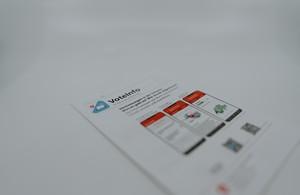Coolhunt Log #19 - Thursday, May 10, 2007 - Peter Gloor

Coolhunt Log #19
Thursday, May 10, 2007
On Stage:
Scott Cooper, MIT research affiliate with the Sloan School of Management, co-author of Coolhunting
Peter Gloor, MIT research affiliate with the Sloan School of Management, co-author of Coolhunting
Raymond Miles, Professor Emeritus and former Dean of the Haas Organizational Behavior and Industrial Relations Group, University of California - Berkeley
Scott Capdevielle, CEO and Founder of Syndicom and SpineConnect
Steve O'Keefe, moderator
MODERATOR: I'm calling from my business office in New Orleans. Could you tell us where you're calling from?
PETER: I'm calling from my home office in Switzerland.
SCOTT: I'm calling from my home office in Newton Highlands, MA.
MODERATOR: We have two special guests with us today. Raymond Miles is Professor Emeritus and former Dean of the Haas Organizational Behavior and Industrial Relations Group at the University of California at Berkeley. We also have Scott Capdevielle who is CEO and Founder of Syndicom and SpineConnect. Ray and Steve, can you tell us where you're calling from?
SCOTT C: I'm calling from Derango, CO.
RAY: I'm calling from my office at the Haas School of Business in Berkeley, CA.
SCOTT C: We're going to start with a website that we've built to help surgeons connect with one another. I can give the user name and password so those following along can log in. This is our demo server. Direct your browser to www.demo.spineconnect.com/sc. Log in using "demouser" and "password."
WEB: https://demo.spineconnect.com/sc/app
SCOTT C: I was a student at Berkeley and started reading books on organizational design, and I kept running into books by Ray Miles. After reading one particular book I became enamored with the concept so I looked him up and went to his office. Finding him sitting there at his desk we starting talking, and he ended up becoming a consultant to my company and a mentor to me. I started working on a concept later and came to Ray with some needs I saw about being an entrepreneur. Roadblocks I saw included the fact that innovators were at a tremendous disadvantage when they were working with a large company. So back in 2000, Ray was trying to understand why open source software organizations were out performing groups who kept their information more concealed.
RAY: We saw that when knowledge was freely exchanged everyone prospered more.
PETER: As a recent example, we found that the more companies collaborated over the course of a year the higher their productivity and high levels of success.
MODERATOR: so what you're saying is that When there's networking across and between corporations, the performance exceeded those of the more closed off ones?
SCOTT C: What Ray discovered back then is that there's a new organizational form. I wanted to know if I could apply that to medicine, and we chose spine surgery. Orthopedics is the fastest growing medical field in terms of innovation. We had to figure out what would be an appropriate way to use open source. Historically, "Hallway Consult" is the way info was transferred among professionals.
MODERATOR: Can you show us how people interact with this software?
SCOTT C: Click on the Groups link at the top of the page. We find that primary growth is through the fellowship program. this site has become popular when fellows have finished their 1-year training but want to stay connected. Click on the Browse button on the left panel and click on Browse Group. Then click on Cleveland Clinic. Then you can submit a request to join this group. You can also create your own group by clicking on the second button, "create a group," in the left panel.
SCOTT: Thus far, it appears that these are largely communities of practice. Peter and I have recently been discussing differences between COINs and communities of practice. I'm curious: what innovations have emerged from the collaboration among these groups and surgeons?
SCOTT C: What we recognized is that if we wanted to create a collaborative network, we had to get the members together first. Once you create a group you can invite members by sending an invitation. When you look at a member's profile you see their training, interests, and other groups they're members of. Back to the menu bar, select Groups, then click on the SOLAS XLIF Discussion link.
WEB: https://demo.spineconnect.com/sc/groupinfo.svc?groupId=72
SCOTT C: We've created a "Technology Fellowship" page here because we understand that people learn more effectively by being trained by their peers. SOLIS is a society and XLIF is a product and a procedure.
MODERATOR: It stands for eXtreme Lateral Interbody Fusion, which sounds painful.
SCOTT C: When you first join, you need to go through the training, then you're free to post your case to get the feedback from the expert doctors who have driven the technology. Now, click on the case "Possible XLIF with decompression?"
WEB: https://demo.spineconnect.com/sc/case.svc?contentId=1187
SCOTT C: What you see here is a surgeon describing his patient in much detail. You can view case the specifics of his case, as well as x-rays, right there by clicking in the proper section on the site. Participants will discuss the case and how they would approach the it if it were theirs.
RAY: This is appropriate collaborative behavior conducted on the web, which had to be learned since doctors were not use to collaborating using this technology.
MODERATOR: How has it been received by users?
SCOTT C: People have been excited about creating a network of supporting peers. Surgeons are doing more cases because they're getting more confidence by hearing more feedback from their peers.
PETER: How do you get participation?
SCOTT C: There's no reward in the open community. Fundamentally, when people reach a certain level in their career, they get success by sharing their knowledge.
RAY: Scott and his group recognized themselves as examples of excellent consultation. There was recognition, but it was coming from Scott and his group, which was very useful early on, but it carried over to surgical colleagues once they saw the usefulness of this site. Now, appreciation for the site -- and the consequent recognition -- has been growing and has become the norm across the group.
SCOTT C: The surgeons now are coming to us with queries about new applications, so we created a research tool. We wanted to know where we could improve, and the users opened up to their communities. It is important for data collection and reporting to be useful. Go to Add a Case on the left side, select the Private Group radio button, then Continue. This page allows you to add images and files.
WEB: https://demo.spineconnect.com/sc/CaseType.page
SCOTT C: In one situation, a doctor posted his case here and was contacted by someone who currently was reviewing a peer-reviewed research paper on the topic. He gave useful, unpublished, information that probably helped the patient greatly avoid a potentially dangerous and painful surgery. So far we have 10 patents in various stages of submittal for spinal implant treatments and devices. We created a process and methodology to enable teams to form to create patents rapidly. So now we have mechanical engineers with medical device experience involved, as well as patent attorneys, at a cost of less than $1,000 per patent. It's a manual process right now that had to be architected via software and currently is in a design phase. The allocation of equity is part of the software.
RAY: These Colab Comm (surgeons and other skills) have behaved pretty much as we thought they would and they do agree on the distribution of shares. The contributions of the team leads everyone to behave correctly in the allocation of equity. This is becoming model behavior, and we had predicted that this would be emergent -- that collaborative communities would develop the capability to behave in their relationships.
PETER: Who brings in the other experts such as lawyers and technicians?
SCOTT C: I've gone out and talked with dozens of patent attorneys and mechanical engineers to find those with an entrepreneurial mind and attitude. And I've been introduced to the surgical community by others as well. We envision creating a learning community and connecting everyone. Our community is a qualified open community.
PETER: You need 10 years of training just to understand the language.
MODERATOR: Right. Some of the names of the links are such that I can't even figure out what they are about.
PETER: Even looking at programmer's open source community sites, they seem pretty rude to outsiders.
SCOTT: At what point in the innovation process do you find that those involved begin to want to protect their property?
SCOTT C: A venture comes to me typically, and I agree to facilitate a round of interviews with all essential personnel required to take this to submit a patent. I ask the inventor to divide the pie and figure out how much work and what kind of work and complexity is going to be involved.
SCOTT: Do you have any instances of innovation where there's no desire for remuneration?
SCOTT C: I had a knee surgeon come to me about these plates that he uses as standard equipment. He wanted to create his own plate and didn't care if he made any money. He just wanted to stop paying $1,000 for something that should cost $50.
SCOTT: Have there been any discussion of a creative commons approach to some of these innovations?
SCOTT C: You could use the knee plate example and our own example of developing commodity products where patents have expired. We're a small company and doing what we can to keep on our core mission. We'll probably open more in the future to a creative commons format.
RAY: What Syndicom has done is take what we've anticipated would happen and make it happen. Within a domain where everyday behavior was different, it has changed to be more collaborative. These are true collaborative communities where innovation develops. You're tapping into the creativity of the community in a much more generous way than what's happened in the past.
PETER: This seems to be one of the most advanced social communities I've seen. While the software may be nothing more than a beefed up version of a Yahoo group, true innovation has grown from it. I'm wondering if all this trust building is because they know one another only online or is it because they've known each other from face-to-face acquaintances at conferences?
SCOTT C: We've actually seen surgeons who have shared cases online but haven't met until a conference. In our second year now we've seen surgeons go abroad and do surgeries with donated equipment. When they leave, the surgeries go back to the way they were done prior to the surgeons' visits. But we're now trying to change this by having surgeons train others abroad using our software.
MODERATOR: Have you done anything to address language issues for international doctors.
SCOTT C: No, to date everything has been in English, but we haven't had any problem since English seems to be a common language among surgeons.
MODERATOR: How about remote surgery?
SCOTT C: We have one customer who has asked about his, and we might approach that in the future. But our current process really just augments current procedures.
RAY: We had not found anything like Syndicom, so when we wrote our book we created a fictional company. So what Syndicom has done is to become this company -- in real life.
GARY: Are there any plans to create a print version anthology of particularly interesting cases that can be researched and read at a glance, such as the knee plate case or the one where the patient avoided the dangerous and painful surgery? This could prevent surgeons from having to sift through so many cases.
SCOTT C: Good question. We actually do put out an email newsletter to highlight cases. Also, a couple surgeons have approached me to publish a compendium of cases.
MODERATOR: We are out of time. Thank you, Scott, Peter, and our special guests Ray Miles and Scott Capdevielle. Listeners, please post your comments to the blog -- whether they're about any connection problems you're experiencing or commentary on the subject of today's coolhunt. The transcript of today's coolhunt will be posted with previous ones at The Swarm Creativity Blog:http://swarmcreativity.blogspot.com/. Join us on Friday for the next installment of our live, online coolhunt with Peter Gloor and Scott Cooper.
Copyright Notice: Please feel free to duplicate or distribute this log as long as the contents are not altered and this notice is intact.
Thank you.
Recommended Articles
Seeing is Believing.
Many software demonstrations end up being generic product promotions. We take the time to understand your specific needs before preparing a customised demonstration that provides you with: • Case studies of how organisations similar to yours have used our technology to improve related issues. • Scientific evidence published in major journals to back-up our statements. Please complete this form and a platform expert will be in touch shortly to take you through a demo of our technology with evidence relevant to your needs.



